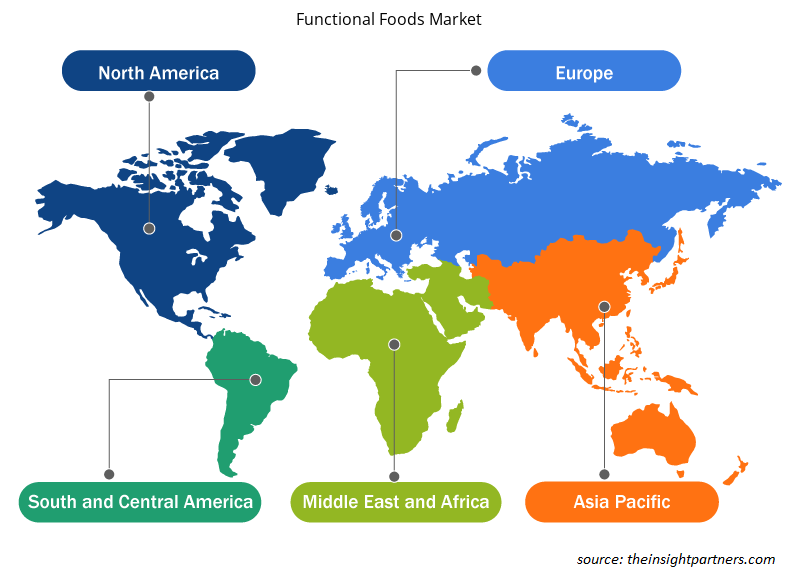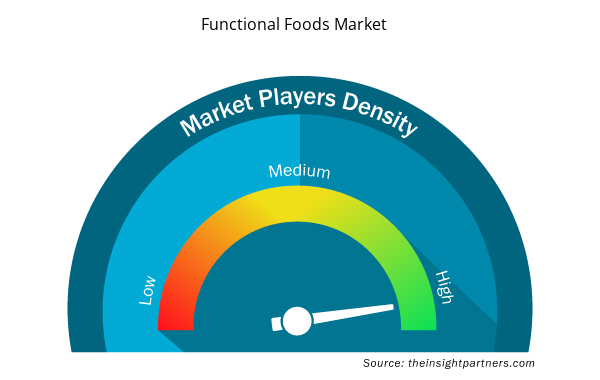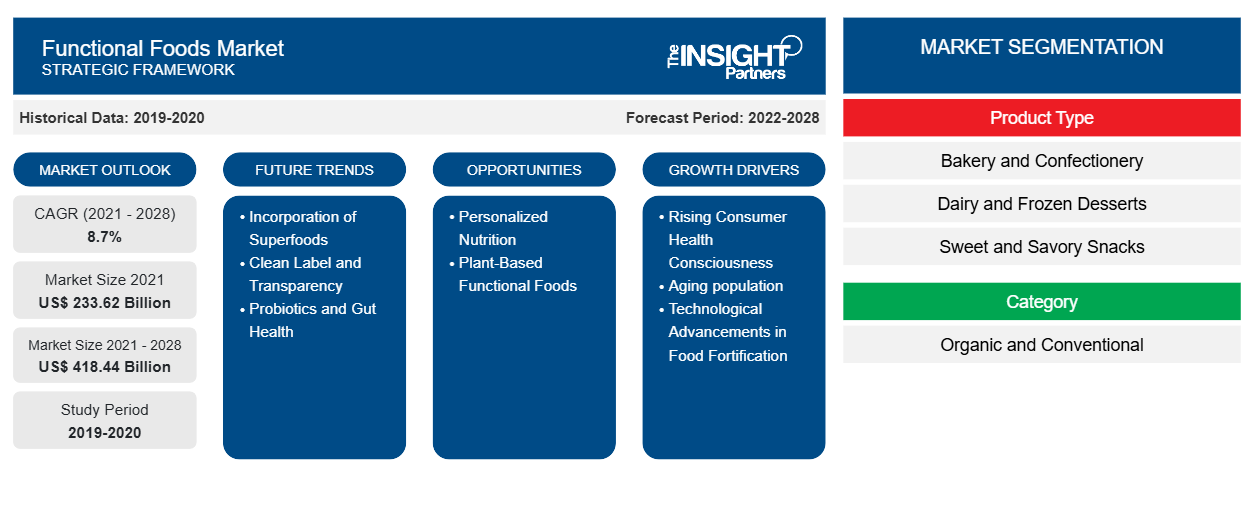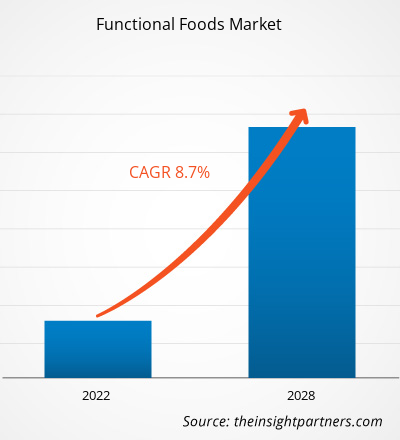기능성 식품 시장은 2021년에 233,620.18백만 달러로 평가되었으며 2028년까지 418,439.42백만 달러에 도달할 것으로 예상됩니다 . 2021년부터 2028년까지 연평균 성장률 8.7% 로 성장할 것으로 예상됩니다 .
기능성 식품은 다양한 식단의 일부로 적절한 양을 정기적으로 섭취할 경우 건강상의 이점과 필수 영양소( 예 : 비타민과 미네랄)를 제공하는 전체, 강화, 강화 또는 개량 식품입니다. 기능성 식품은 뼈 건강 증진, 콜레스테롤 관리 및 심장 건강 개선과 같은 일반적인 일일 영양소 섭취를 넘어서는 고유한 건강상의 이점이 있습니다. 또한 기능성 식품 시장 확대는 영양가 있고 강화하는 식품 첨가물 에 대한 수요 증가로 인해 촉진될 것으로 예상됩니다 . 식품 제조업체는 오메가-3 지방산, 섬유질, 비타민 및 미네랄과 같은 건강한 첨가물로 제품을 강화하고 있습니다. 위에서 언급한 첨가물을 식품 산업에 추가하는 목적은 식품의 영양가를 높이는 것입니다.
아시아 태평양 지역은 2020년 글로벌 기능성 식품 시장 에서 가장 큰 점유율을 차지했으며 아시아 태평양 지역은 예측 기간 동안 상당히 성장할 것으로 예상됩니다. 소비자 관심 증가와 적절한 식단 및 식습관의 면역 강화 특성에 대한 더 나은 이해는 이 지역에서 기능성 식품의 확장을 촉진하는 주요 요인 중 하나입니다. 또한 패스트푸드 섭취는 건강 상태에 해로운 변화를 일으키고 당뇨병 및 비만과 같은 만성 질환의 발생률을 증가시키고 있습니다. 소비자는 이러한 건강 문제에 대해 더 많이 알게 됨에 따라 전반적인 건강을 증진하기 위해 영양 식품에 더 많은 돈을 쓰고 있으며, 이는 이 지역의 기능성 식품 시장 성장을 증가시킵니다.
귀하의 요구 사항에 맞게 이 보고서를 사용자 정의하세요
이 보고서의 일부 또는 국가 수준 분석, Excel 데이터 팩을 포함하여 모든 보고서에 대한 사용자 정의를 무료로 받을 수 있으며 신생 기업 및 대학을 위한 훌륭한 혜택과 할인 혜택을 이용할 수 있습니다.
- 이 보고서의 주요 시장 동향을 알아보세요.이 무료 샘플에는 시장 동향부터 추정 및 예측까지 다양한 데이터 분석이 포함됩니다.
기능성 식품 시장에 대한 COVID-19 팬데믹의 영향
COVID-19 팬데믹은 전국적인 봉쇄 , 사업 중단 및 공급망 중단으로 인해 많은 산업에 영향을 미쳤습니다. 기능성 식품 시장에 팬데믹의 영향은 엇갈렸습니다. 처음에는 봉쇄 와 사업 중단으로 인해 제조업체는 원자재와 노동력이 부족하여 생산과 공급에 영향을 미쳤습니다. 그러나 사람들이 건강을 더 의식하게 되면서 건강 증진 제품을 선호했습니다. 기능성 식품은 뼈 건강을 개선하고 콜레스테롤 수치와 심장 건강을 관리하는 데 도움이 되므로 상당한 수요가 있었습니다. 게다가 기업의 긍정적이고 강렬한 마케팅과 의사, 영양사 등 건강 전문가의 추천으로 인해 기능성 또는 강화 식품에 대한 수요가 많은 지역으로 확대되었습니다. 예를 들어, 4월 조사를 기반으로 한 Hartman Group의 Functional Food & Beverage 2020 보고서에 따르면 소비자의 31%가 더 많은 보충제를 복용하고 29%가 팬데믹으로 인해 더 많은 기능성 식품/음료를 소비하고 있습니다. 게다가 많은 국가에서 백신을 접종했고 정부는 제조 및 무역에 부과된 제한을 완화했습니다. 따라서 코로나19 팬데믹은 기능성 식품 시장에 상당한 영향을 미쳤습니다.
시장 통찰력
건강한 간식에 대한 수요 증가
최근 소비자 행동의 변화로 인해 전 세계 간식 시장은 기름기 많고 매운 간식에서 벗어나 소량으로 포장된 건강하고 무설탕, 영양이 풍부하고 저유분 간식으로 이동하고 있습니다. 이는 기능성 식품 시장의 성장을 촉진하고 있는데, 이러한 식품은 일반적으로 비타민, 미네랄, 건강한 지방, 섬유질을 포함한 중요한 영양소가 풍부하기 때문입니다. 신세대 소비자는 일상적인 영양 요구 사항을 충족하면서도 미각을 자극하는 영양가 있고 이동 중에 먹을 수 있으며 저렴한 간식 옵션을 찾습니다. 예를 들어, 최근 Mondelez 설문 조사에 따르면 전 세계 성인의 59% 이상이 몇 번의 큰 식사보다는 하루 종일 여러 번의 작은 식사를 선호합니다. 소비자는 에너지, 집중력, 휴식을 위한 기능성 간식에 점점 더 관심을 갖고 있으며, 특히 바와 식사 대용품 식품의 형태가 그렇습니다. 또한, 개인화된 영양소 프리믹스를 간식 식품에 통합하는 것은 오메가-3 지방산, 비타민, 미네랄과 같은 유익한 영양소를 통합하는 효과적인 전략입니다. 기능성 간식은 배를 채울 뿐만 아니라 배고픔을 오래 지속시키는 치료제이기도 합니다. 이러한 성분은 영양이 풍부한 음식을 섭취하는 동안 신체에 필요한 구성 요소를 공급합니다. 결과적으로 사람들은 하루 종일 배고픔을 덜 느낄 것입니다. 이 요인은 향후 몇 년 동안 글로벌 기능성 식품 시장에 영향을 미칠 몇 가지 주요 트렌드를 제공할 것으로 예상됩니다.
카테고리 통찰력
카테고리에 따라 기능성 식품 시장은 유기농과 재래식으로 구분됩니다. 재래식 세그먼트가 더 큰 시장 점유율을 차지했습니다. 유기농 세그먼트는 예측 기간 동안 더 빠른 CAGR로 성장할 것으로 예상됩니다. 유기농 기능성 식품에 대한 소비자의 수요 증가로 인해 기업과 재배자는 유기농 농업을 장려하게 되었고, 이것이 세그먼트를 주도하고 있습니다. 제조업체는 소비자의 증가하는 수요에 부응하기 위해 유기농 기능성 식품을 개발하고 있습니다. 예를 들어, 포장된 인증 유기농 아침 시리얼을 생산하는 미국의 제조업체인 Nature's Path Foods는 Organic Optimum Power Breakfast Cereal에 대한 엄청난 성장을 보고했습니다. 따라서 건강에 대한 인식과 살충제의 해로운 영향에 대한 인식이 높아짐에 따라 유기농 식품에 대한 수요가 증가하면서 유기농 기능성 식품 세그먼트가 주도되고 있습니다.
제품 유형 통찰력
제품 유형에 따라 기능성 식품 시장은 제빵 및 제과, 유제품 및 냉동 디저트 , 달콤하고 짭짤한 간식, 아침 시리얼 등으로 세분화됩니다. 유제품 및 냉동 디저트 부문은 예측 기간 동안 글로벌 기능성 식품 시장에서 가장 큰 시장 점유율을 차지할 것으로 예상됩니다. 발효 유제품은 건강상의 이점을 제공하며 기능성 유제품의 범위를 넓히고 있습니다. 이와 함께 우유가 제공하는 영양상의 이점은 만성 질환을 통제하는 데 중요한 역할을 합니다. 강화 우유에는 다양한 영양소가 포함되어 있으며 비타민 A와 D의 좋은 공급원이며 어린이의 철분 결핍 빈혈을 예방하는 데 도움이 됩니다. 또한 강화 우유는 칼슘, 인 및 비타민 D의 좋은 공급원이기 때문에 뼈 건강을 개선하는 데 도움이 됩니다. 냉동 디저트는 기본적으로 액체, 반고체, 때로는 고형물을 동결시켜 만든 디저트입니다. 기능성 냉동 디저트는 프리바이오틱스 및 프로바이오틱스와 같은 다양한 기능성 성분을 포함하므로 소비자에게 건강상의 이점을 제공합니다. 따라서 기능성 냉동 디저트가 제공하는 건강상의 이점은 글로벌 기능성 식품 시장에서 세그먼트의 성장을 촉진하고 있습니다.
유통 채널 통찰력
유통 채널을 기준으로 기능성 식품 시장은 슈퍼마켓 및 하이퍼마켓, 편의점, 온라인 소매 등으로 세분화됩니다. 슈퍼마켓 및 하이퍼마켓 부문은 2020년 기능성 식품 시장에서 가장 큰 시장 점유율을 차지한 반면, 온라인 소매 부문은 예측 기간 동안 가장 빠르게 성장할 것으로 예상됩니다. 전자 상거래 붐은 기능성 식품의 온라인 소매 판매에 상당한 기회를 효과적으로 제공했습니다. 팬데믹이 시작된 후, 선도적인 제조업체는 매력적인 가격, 강력한 판매 및 지원, 소비자를 위한 업그레이드된 쇼핑 경험이 혼합된 인기 있는 전자 상거래 플랫폼에 보다 적극적으로 접근하고 있습니다. 이러한 측면은 온라인 플랫폼이 전 세계적으로 가장 빠르게 성장하는 유통 채널 중 하나가 되는 데 도움이 될 것으로 예상됩니다. 이러한 요인들이 기능성 식품 시장의 온라인 소매 채널 부문을 주도하고 있습니다.
기능성 식품 시장에서 활동하는 주요 기업으로는 Unilever, Clif Bar & Company, Laird Superfood, Abbott, Danone SA, GENERAL MILLS, INC, HILDUR, Nestlé, Kellogg Company, Good Source Foods, LLC가 있습니다. 이러한 기업은 떠오르는 소비자 트렌드를 충족하기 위해 혁신적인 제품을 개발하는 데 참여하고 있습니다. 또한, 이들은 합병 및 인수, 사업 확장, 파트너십에 참여하여 전 세계적으로 시장 점유율을 확대하고 있습니다.
기능성 식품
기능성 식품 시장 지역 통찰력
Insight Partners의 분석가들은 예측 기간 동안 기능성 식품 시장에 영향을 미치는 지역적 추세와 요인을 철저히 설명했습니다. 이 섹션에서는 북미, 유럽, 아시아 태평양, 중동 및 아프리카, 남미 및 중미의 기능성 식품 시장 세그먼트와 지리에 대해서도 설명합니다.

- 기능성 식품 시장에 대한 지역별 특정 데이터 얻기
기능성 식품 시장 보고서 범위
| 보고서 속성 | 세부 |
|---|---|
| 2021년 시장 규모 | 2,336억 2,000만 달러 |
| 2028년까지 시장 규모 | 4,184억 4,000만 달러 |
| 글로벌 CAGR (2021-2028) | 8.7% |
| 역사적 데이터 | 2019-2020 |
| 예측 기간 | 2022-2028 |
| 다루는 세그먼트 | 제품 유형별
|
| 포함된 지역 및 국가 | 북아메리카
|
| 시장 선도 기업 및 주요 회사 프로필 |
|
기능성 식품 시장 참여자 밀도: 비즈니스 역학에 미치는 영향 이해
기능성 식품 시장은 소비자 선호도의 변화, 기술 발전, 제품의 이점에 대한 인식 증가와 같은 요인으로 인해 최종 사용자 수요가 증가함에 따라 빠르게 성장하고 있습니다. 수요가 증가함에 따라 기업은 제품을 확장하고, 소비자의 요구를 충족하기 위해 혁신하고, 새로운 트렌드를 활용하여 시장 성장을 더욱 촉진하고 있습니다.
시장 참여자 밀도는 특정 시장이나 산업 내에서 운영되는 회사나 기업의 분포를 말합니다. 주어진 시장 공간에 얼마나 많은 경쟁자(시장 참여자)가 존재하는지 그 규모나 총 시장 가치에 비해 나타냅니다.
기능성 식품 시장에서 활동하는 주요 기업은 다음과 같습니다.
- 애벗 연구소
- 클리프 바 앤 컴퍼니
- 다논 SA
- 제너럴 밀스 주식회사
- 굿소스푸드 주식회사
면책 조항 : 위에 나열된 회사는 어떤 특별한 순서에 따라 순위가 매겨지지 않았습니다.

- 기능성 식품 시장의 주요 기업 개요를 알아보세요
스포트라이트 보고서
- 기능성 식품 시장의 진보적인 산업 동향은 플레이어가 효과적인 장기 전략을 개발하는 데 도움이 됩니다.
- 선진국과 개발도상국 시장에서 채택한 사업 성장 전략
- 2019년부터 2028년까지 기능성 식품 시장의 정량적 분석
- 기능성 식품에 대한 세계 수요 추산
- 산업에서 운영되는 구매자와 공급자의 효율성을 설명하기 위한 포터의 5가지 힘 분석
- 경쟁 시장 시나리오를 이해하기 위한 최근 개발
- 기능성 식품 시장 성장을 촉진하고 억제하는 요인과 더불어 시장 동향 및 전망
- 상업적 관심을 뒷받침하는 시장 전략을 강조하여 의사 결정 프로세스를 지원하고 시장 성장을 이끕니다.
- 다양한 노드에서의 기능성 식품 시장 규모
- 시장의 세부적인 개요 및 세분화, 기능성 식품 산업 역학
- 성장 가능성이 유망한 다양한 지역의 기능성 식품 시장 규모
- 역사적 분석(2년), 기준 연도, CAGR을 포함한 예측(7년)
- PEST 및 SWOT 분석
- 시장 규모 가치/양 - 글로벌, 지역, 국가
- 산업 및 경쟁 환경
- Excel 데이터 세트



Report Coverage
Revenue forecast, Company Analysis, Industry landscape, Growth factors, and Trends

Segment Covered
This text is related
to segments covered.

Regional Scope
North America, Europe, Asia Pacific, Middle East & Africa, South & Central America

Country Scope
This text is related
to country scope.
자주 묻는 질문
Based on product type, the sweet and savory snacks segment was the fastest-growing segment in the market. The growing trend of healthy snacking across regions such as North America, Europe, and the Asia Pacific is driving the demand for savory snacks across the world. Consumers are increasingly interested in functional snacks for energy, focus, and relaxation, particularly in the form of bars and meal replacement foods.
In 2020, the dairy & frozen dessert segment accounted for the largest functional foods market share, based on product type. Consumers are increasingly consuming dairy products as it is important for building healthy bones and for maintaining a healthy weight. Yogurt is the most popular functional dairy product and is an excellent source of protein, calcium, and potassium. Also, there is a growing trend of fortification of dairy products which further drives the growth of the segment.
The increased demand for nutrient-rich foods as well as the increased prevalence of chronic diseases across the world is driving the growth of the functional foods market. Along with this, the COVID-19 pandemic has had a significant impact on consumer buying behavior and eating habits. There has been an increase in health concerns and the growing awareness regarding the consumption of natural and functional food post-pandemic which is also driving the growth of the functional foods market. Along with this, the rising trend of healthy snacking across the world is also increasing the demand for functional foods.
The market for the organic segment is expected to grow at a faster pace during the forecast period due to the increased concern regarding personal health, the environment, and animal welfare. The growing environmental concerns over the use of harmful chemicals in agriculture and farming and its harmful effects on consumers’ health have led to an increased demand for organic functional foods.
The major key players operating in the global functional foods market include Abbott Laboratories; Clif Bar and Company; Danone S.A.; General Mills, Inc; Good Source Foods, LLC; Hildur Functional Foods Pvt. Ltd; Kellogg Company; Laird Superfood; Nestlé S.A.; and Unilever Plc.
In 2020, Asia Pacific dominated the global functional foods market. The region is expected to continue its dominance during the forecast period. Trends in this market are influenced by the increased demand for nutrient-rich foods as well as the rising trend of healthy snacking across the region. The increased prevalence of chronic diseases across the region is also driving the demand for functional foods to support the healthier lifestyle of the consumers.
Trends and growth analysis reports related to Food and Beverages : READ MORE..
The List of Companies - Functional Foods Market
- ABBOTT LABORATORIES
- CLIF BAR AND COMPANY
- DANONE S.A.
- GENERAL MILLS, INC
- GOOD SOURCE FOODS, LLC
- HILDUR FUNCTIONAL FOODS PVT. LTD
- KELLOGG COMPANY
- LAIRD SUPERFOOD
- NESTLé S.A.
- UNILEVER PLC
The Insight Partners performs research in 4 major stages: Data Collection & Secondary Research, Primary Research, Data Analysis and Data Triangulation & Final Review.
- Data Collection and Secondary Research:
As a market research and consulting firm operating from a decade, we have published and advised several client across the globe. First step for any study will start with an assessment of currently available data and insights from existing reports. Further, historical and current market information is collected from Investor Presentations, Annual Reports, SEC Filings, etc., and other information related to company’s performance and market positioning are gathered from Paid Databases (Factiva, Hoovers, and Reuters) and various other publications available in public domain.
Several associations trade associates, technical forums, institutes, societies and organization are accessed to gain technical as well as market related insights through their publications such as research papers, blogs and press releases related to the studies are referred to get cues about the market. Further, white papers, journals, magazines, and other news articles published in last 3 years are scrutinized and analyzed to understand the current market trends.
- Primary Research:
The primarily interview analysis comprise of data obtained from industry participants interview and answers to survey questions gathered by in-house primary team.
For primary research, interviews are conducted with industry experts/CEOs/Marketing Managers/VPs/Subject Matter Experts from both demand and supply side to get a 360-degree view of the market. The primary team conducts several interviews based on the complexity of the markets to understand the various market trends and dynamics which makes research more credible and precise.
A typical research interview fulfils the following functions:
- Provides first-hand information on the market size, market trends, growth trends, competitive landscape, and outlook
- Validates and strengthens in-house secondary research findings
- Develops the analysis team’s expertise and market understanding
Primary research involves email interactions and telephone interviews for each market, category, segment, and sub-segment across geographies. The participants who typically take part in such a process include, but are not limited to:
- Industry participants: VPs, business development managers, market intelligence managers and national sales managers
- Outside experts: Valuation experts, research analysts and key opinion leaders specializing in the electronics and semiconductor industry.
Below is the breakup of our primary respondents by company, designation, and region:

Once we receive the confirmation from primary research sources or primary respondents, we finalize the base year market estimation and forecast the data as per the macroeconomic and microeconomic factors assessed during data collection.
- Data Analysis:
Once data is validated through both secondary as well as primary respondents, we finalize the market estimations by hypothesis formulation and factor analysis at regional and country level.
- Macro-Economic Factor Analysis:
We analyse macroeconomic indicators such the gross domestic product (GDP), increase in the demand for goods and services across industries, technological advancement, regional economic growth, governmental policies, the influence of COVID-19, PEST analysis, and other aspects. This analysis aids in setting benchmarks for various nations/regions and approximating market splits. Additionally, the general trend of the aforementioned components aid in determining the market's development possibilities.
- Country Level Data:
Various factors that are especially aligned to the country are taken into account to determine the market size for a certain area and country, including the presence of vendors, such as headquarters and offices, the country's GDP, demand patterns, and industry growth. To comprehend the market dynamics for the nation, a number of growth variables, inhibitors, application areas, and current market trends are researched. The aforementioned elements aid in determining the country's overall market's growth potential.
- Company Profile:
The “Table of Contents” is formulated by listing and analyzing more than 25 - 30 companies operating in the market ecosystem across geographies. However, we profile only 10 companies as a standard practice in our syndicate reports. These 10 companies comprise leading, emerging, and regional players. Nonetheless, our analysis is not restricted to the 10 listed companies, we also analyze other companies present in the market to develop a holistic view and understand the prevailing trends. The “Company Profiles” section in the report covers key facts, business description, products & services, financial information, SWOT analysis, and key developments. The financial information presented is extracted from the annual reports and official documents of the publicly listed companies. Upon collecting the information for the sections of respective companies, we verify them via various primary sources and then compile the data in respective company profiles. The company level information helps us in deriving the base number as well as in forecasting the market size.
- Developing Base Number:
Aggregation of sales statistics (2020-2022) and macro-economic factor, and other secondary and primary research insights are utilized to arrive at base number and related market shares for 2022. The data gaps are identified in this step and relevant market data is analyzed, collected from paid primary interviews or databases. On finalizing the base year market size, forecasts are developed on the basis of macro-economic, industry and market growth factors and company level analysis.
- Data Triangulation and Final Review:
The market findings and base year market size calculations are validated from supply as well as demand side. Demand side validations are based on macro-economic factor analysis and benchmarks for respective regions and countries. In case of supply side validations, revenues of major companies are estimated (in case not available) based on industry benchmark, approximate number of employees, product portfolio, and primary interviews revenues are gathered. Further revenue from target product/service segment is assessed to avoid overshooting of market statistics. In case of heavy deviations between supply and demand side values, all thes steps are repeated to achieve synchronization.
We follow an iterative model, wherein we share our research findings with Subject Matter Experts (SME’s) and Key Opinion Leaders (KOLs) until consensus view of the market is not formulated – this model negates any drastic deviation in the opinions of experts. Only validated and universally acceptable research findings are quoted in our reports.
We have important check points that we use to validate our research findings – which we call – data triangulation, where we validate the information, we generate from secondary sources with primary interviews and then we re-validate with our internal data bases and Subject matter experts. This comprehensive model enables us to deliver high quality, reliable data in shortest possible time.


 이 보고서에 대한 무료 샘플을 받으세요
이 보고서에 대한 무료 샘플을 받으세요